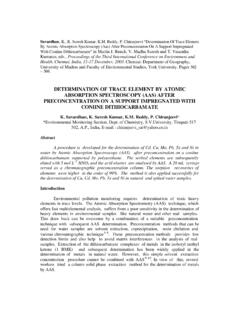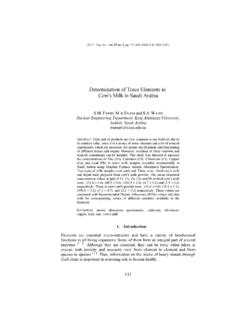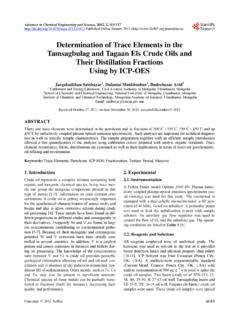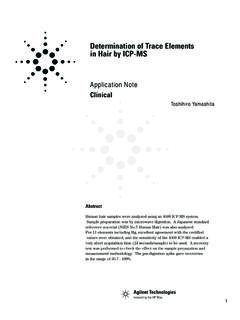Transcription of Evaluation of MiniCollect Z No Additive tubes for …
1 Evaluation of MiniCollect Z No Additive tubes for trace elements determination Background: Greiner-Bio-One, Austria has sold plastic evacuated tubes (VACUETTE ) for venous blood collection since 1986. In addition to the standard product line of VACUETTE and MiniCollect tubes , GBO offers an extensive range of special tubes including tubes for trace element testing. Greiner Bio-One has developed a newly designed MiniCollect tube offering an integrated collection scoop. One advantage of the new tube is that capillaries and funnels are not needed to facilitate blood transfer from the puncture site into the MiniCollect tube. The MiniCollect Z No Additive blood collection tube is also featured with a co-molded cap which can easily be removed during the collection and sampling process. Study Objective: trace elements are inorganic components that are found in the body in a concentration of less than of the body mass, which are amounts of < 10-6 g/g bodyweight.
2 Normal ranges of the tested trace elements are listed below in Table 1. The aim of Evaluation of MiniCollect Z No Additive tubes was to demonstrate the analytical performance and suitability for trace element testing in blood for a variety of trace elements . Study design and procedure: For the study, the following product was used: Sample Description 450542 MiniCollect Z No Additive In total, 30 tubes were filled with 1 ml of deionized water (filling was carried out without any metal-containing devices) in order to provide 10 results for each trace element (3 tubes needed for the complete trace element profile). After filling and closing with the caps, the tubes were inverted 8 times. Standards, controls and the samples were measured by ICP-MS. The tubes were tested for the following trace elements (Table 1) Results The maximum, mean, and standard deviation of testing results of MiniCollect Z No Additive are shown in Table 1.
3 Conclusion: From these results, it can be concluded that the Greiner MiniCollect Z No Additive tube is suitable for trace element analysis in blood or serum for the tested trace elements provided that blank measurements are carried out especially with regard to assessing very low trace element contents. SYN 14 (04/2018) Table 1 Element Normal range in Maximum contamination level in MiniCollect Z No Additve tube [ppb] Mean contamination in MiniCollect Z No Additive tube [ppb] SD of mean contamination in MiniCollect Z No Additive tube [ppb] whole blood [ppb] 1 Plasma/Serum [ppb] 1 Ag Silver < * * Al Aluminium < 5 5 * * As Arsenic < 12 12 * * Ba Barium 100 80 * * Be Beryllium < 4 * * Bi Bismuth < * * Cd Cadmium < * * Cr Chromium 3-6 < * * Co Cobalt * * Cu Copper < 1400 * * Hg Mercury * * I Iodine 40-80 * * Li Lithium < 70 * * Mn Manganese * * Mo Molybdenum 1-10 < 6 * * Ni Nickel < * * Pb Lead < 100 * * Se Selenium 60-125 55-103 * * Sb Antimony < * * Sn Tin < 5 * * Te Tellurium * * Th Thorium < < * * Tl Thallium < * * U Uranium < 60 * * Zn Zinc 400-750 700-1500 * * 1 see Ref (1).
4 Not available *Detection limit of ICP-MS: for Cd, Hg, Pb, Tl, U: < ppb for I, Al: < 2 ppb for all other trace elements : < ppb A blank value determination is always strongly recommended in order to obtain reliable values and rule out day-dependent deviations. References: (1) Woittiez J., Iyengar V, trace elements in Human Clinical Specimes: Evaluation of Literature Data to identify Reference values; Clinical Chemistry, Vol. 34, No. 3, 1998 (2) Thomas L., Labor und Diagnose. TH-Books, 7. Auflage (2008) (3) Tietz , Clinical Guide to Laboratory Tests. Saunders Company, third edition (1995) (4) Guder , Narayanan S., Wisser H., Zwata B., Samples: From the Patient to the Laboratory. Wiley-VCH, third revised edition (2003) (5) FDA Approval Greiner trace Element tubes (6) CLSI C38A: Control of Preanalytical Variation in trace Element Determinations, Approved Guideline









